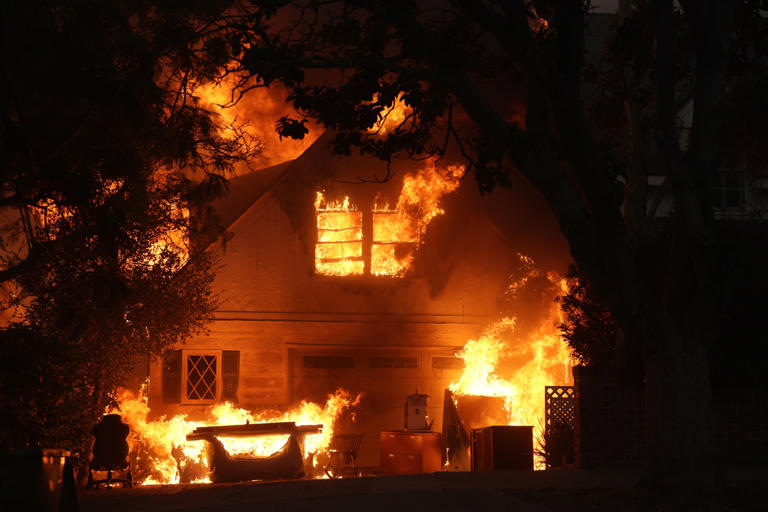“Chaos Unfolds: On-the-Ground Scenes as the Pacific Palisades Fire Rages”
In an instant, everything turned black, and flames flared outside car windows. Fire trucks roared past as drivers braked, flipped around, and drove through walls of thick, choking smoke on the wrong side of the road. Cyclists skidded to a halt, covering their faces as gusting winds pushed sharp smoke directly at them.
On a nearby street, an eerie silence was punctuated by the crackling of flames. One home burned brightly behind a white picket fence, its massive orange flames reflected in the wide eyes of stunned residents who had stayed behind. Cars hesitated at intersections, some trying to venture toward the smoke-covered glow near the high school, only to retreat as flames danced below. Another home ignited, while a neighboring house stood eerily intact, its Christmas tree glowing in an abandoned, brightly lit living room.
The Palisades Fire erupted in a way that residents knew was possible but were still unprepared for. Fierce winds swept through early Tuesday, fueling the blaze that grew uncontrollably within minutes. Firefighters and police scrambled as the inferno outpaced them. “It’s going to burn everything,” one sergeant muttered grimly over his radio as flames neared Palisades High School.
On Sunset Boulevard, chaos reigned. Abandoned cars were smashed together, their mirrors and doors destroyed after a fire department plow cleared a path for emergency vehicles. The fire’s speed left no time for hesitation. Officers ordered drivers to abandon their vehicles and run as flames bore down. “The fire was literally right on top of them,” said officer Tim Estevez.
“We told them, ‘You need to go now,’” Estevez explained, gesturing to show just how close the flames had come. A bottleneck of fleeing cars clogged narrow, winding streets, leaving hundreds of residents stranded and desperate to escape.
By 3 p.m., officers at Sunset and Palisades Drive watched as hillside residents, trapped for hours, finally navigated their way out through streets littered with wrecked cars. The evacuation was chaotic, with officers lamenting the lack of communication and coordination. “There was no communication,” one officer said, shaking his head at the logistical nightmare of funneling so many people out of a densely populated area with only one viable exit route.
The sudden, fast-moving fire served as a chilling reminder of how quickly disaster can strike. For residents, the harrowing evacuation mirrored the deadly scenes from Lahaina during the Maui wildfires, where similar bottlenecks left many trapped. Social media lit up with reports of residents stuck in their cars, unable to move, as the flames consumed everything around them.
Desperation and Chaos as Pacific Palisades Fire Pushes First Responders to Their Limits
“The fire was burning so bad,” Sergeant Rich Adams explained, “we couldn’t send people one way. But the other side was just as bad.”
Caught between two raging fire fronts, residents had nowhere to go. “You have two sides with people in the middle—what are you going to do with them?” Adams said. Knowing the area’s hidden backroads, he picked a route and started sending cars through.
“Someone has to take the lead, and nobody was,” he added.
As evacuees were funneled toward Pacific Coast Highway, Bryan Espin, a veteran community officer with 18 years of experience in the area, described the evacuation as “out of control.” Cars from uphill neighborhoods poured onto narrow, two-lane roads, quickly clogging escape routes. Some, in a panic, drove toward the advancing fire.
“It’s all dictated by the event itself,” Espin said. “And with this being the only road out, it’s always dangerous.”
Compounding the disaster was the fact that the area hadn’t burned in years, creating a tinderbox of dry vegetation. Espin recalled a small fire on New Year’s Eve in the same vicinity, speculating it might have been a precursor. “Any wind-driven fire like this there’s very little you can do to slow it down.”
For both Adams and Espin, this was the worst fire they had ever experienced in over two decades of service.
As night fell, the fire reached the coastline. Flames raced up palm trees like Christmas lights, while dense, acrid smoke thickened the air. Fire trucks lined the parking lot at Will Rogers State Beach, near the Getty Villa, which was engulfed in flames. Dispatchers crackled over radios, prioritizing life safety and structure defense, strategizing how to hold the line if the winds died down.
Amidst the chaos, a man appeared, walking a bicycle between rows of flashing red lights. Distraught and gasping, he pleaded with firefighters. “I need my dogs—they’re my family,” he cried. His home was near the high school, where flames were rapidly spreading. Unable to drive home due to road closures, he had rented a bike and tried to reach them on foot, repeating his address in desperation.
The Palisades fire’s relentless speed and intensity left first responders stretched thin and residents in a state of sheer panic, highlighting the devastating power of wind-driven wildfires in an unprepared landscape.
